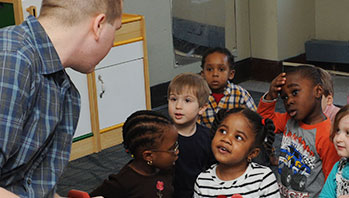- Eating the Alphabet (book)
- ethnic vegetables (see Chicks and Salsa and The Ugly Vegetables)
- leaf vegetables (such as lettuce, bok choy, and spinach with roots attached)
- root vegetables (such as carrots and radishes with leaves attached, if possible)
- grow
- fruit
- ingredient
- plant
- vegetable
MA Standards:
Speaking and Listening/SL.PK.MA.1: Participate in collaborative conversations with diverse partners during daily routines and play.
English Language Arts/Language/L.PK.MA.6: Use words and phrases acquired through conversations, listening to books read aloud, activities, and play.
Head Start Outcomes:
Language Development/Receptive Language: Attends to language during conversations, songs, stories, or other learning experiences.
Language Development/Expressive Language: Uses language to express ideas and needs.
Logic and Reasoning/Reasoning and Problem Solving: Classifies, compares, and contrasts objects, events, and experiences.
PreK Learning Guidelines:
English Language Arts/Language 2: Participate actively in discussions, listen to the ideas of others, and ask and answer relevant questions.
Talk Together: Vegetables

© Commonwealth of Massachusetts, Department of Early Education and Care (Jennifer Waddell photographer). All rights reserved.
STEM Key Concepts: Many foods that animals, including humans, eat come from plants; We eat certain leaves, roots, fruits, and seeds; Plants exhibit diversity and variation
ELA Focus Skills: Listening and Speaking, Vocabulary
Talk with children about what they know about vegetables. Display the book Eating the Alphabet, which you read last week, and ask children to recall what they know about vegetables from the book.
- Say, There were many different fruits and vegetables in this book. Many of them come from different places in the world. Remind children that in the glossary of the book, they can read where in the world many of these plants come from.
- Review how people eat plants and parts of plants. Say, All over the world, people grow different plants to eat.
- Talk about how people use the same plants in different ways. Discuss how people use different ingredients that can make a familiar food taste different. Ask children to tell you about a favorite vegetable their family eats a lot at home or on special occasions.
Cultural Connection: This is a good opportunity to have children from different cultures share vegetables that are important to their culture. Ask children from ethnic traditions if they have any vegetables that they eat at home that are a special part of their family meals. Ask them to describe them. You may want to contact family members to ask them to identify or send in any vegetables that are important to their tradition so you can include them in the daily discussions around plants.
Social Emotional Tip: Group discussions allow children to practice taking turns, staying on topic, and actively listening.
